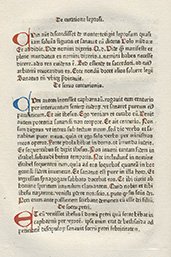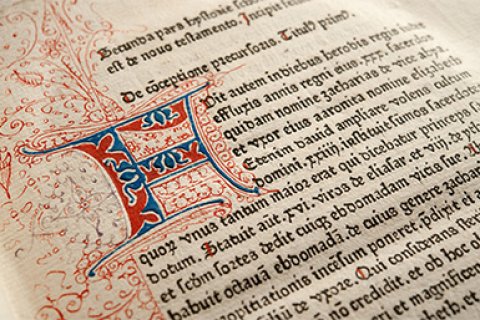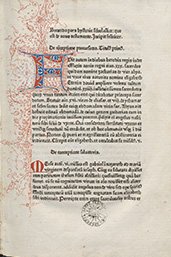'Historia scholastica' by Petrus Comestor
The first dated printed book in the Northern Netherlands

In 1473 the city of Utrecht had a real scoop. Here the first dated book appeared in the Northern Netherlands, printed in movable type using lead letters: the Historia scholastica by Petrus Comestor (ca. 1100-1179). This early print, a so-called incunable, came from the presses of the Utrecht book printers and publishers Nicolaes Ketelaer and Gerard de Leempt. The work testifies to the remarkable printers’ history of Utrecht, to which the University Library has devoted a digital exhibition of Utrecht incunables.
Prototypography
We cannot say with a 100% certainty if the earliest beginning of the Dutch art of book printing started in Utrecht. Through paper study we now know that even before 1473 books were printed in the Netherlands. However, the book printers and their locations are unknown and their legacy is called prototypography. Even so, the Historia scholastica by Ketelaer and De Leempt proves that Utrecht has played a distinctly important role in the earliest days of Dutch book printing.
Bible in prose

The text of the Historia scholastica that Ketelaer and De Leempt printed and published was already a few centuries old. French theologian Petrus Comestor wrote the Historia scholastica in the period between 1169 and 1175. In this monumental work he recounted the Bible in prose for the benefit of education in theology. Comestor also added all kinds of profane historical and geographical sources to explain Biblical passages.
Devouring books
The Historia scholastica is the most extensive summary of Biblical history from the Middle Ages. Because of his enormous zest for work and because he was a man of wide reading Comestor was nicknamed ‘Manducator’ which means a devourer of books. He collected his data from a large number of sources. As said before, the Historia scholastica was initially handed down in manuscript copies. The Utrecht University Library is the lucky owner of such a manuscript version, which can be consulted online (Ms. 262; shelfmark HSS: Hs. 4 J 15).
Only the New Testament
In 1473 the work came from the printing press for the first time and in two editions: one at Günther Zainer in Augsburg and one at Ketelaer and De Leempt, the incunable shown here. However, the Utrecht edition only contains the treatise on the New Testament (‘De Novo Testamento’) and not the one on the Old Testament. Yet unthinkingly the typesetter had the first book start with ‘Secunda pars’ (Second part) whereas it was never Van Ketelaer’s and De Leempt’s intention to publish a first part.
Confusion

Of course the term ‘Secunda pars’ led the public astray and soon for parts of the edition the leaves with the misleading text were replaced by new leaves bearing the text ‘Scolastica hystoria super novum testamentum’ ('The Historia scholastica regarding the New Testament'). However, the Utrecht copy has the ‘wrong’ text.

